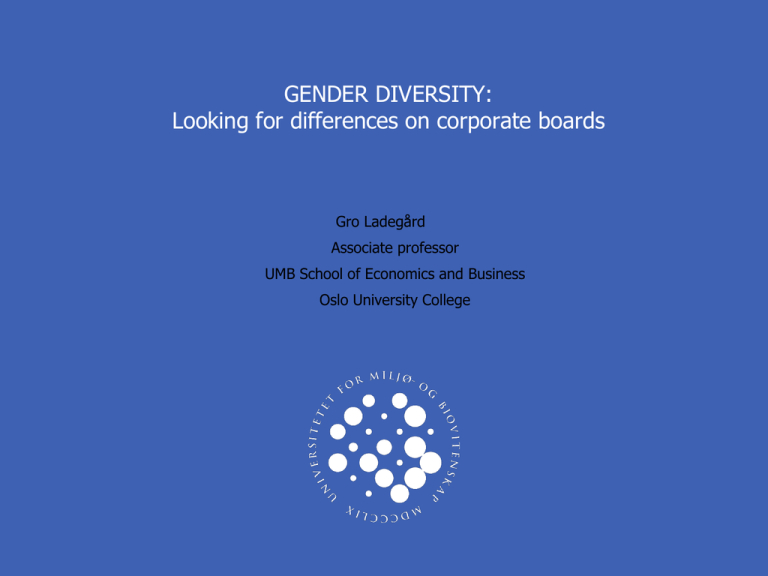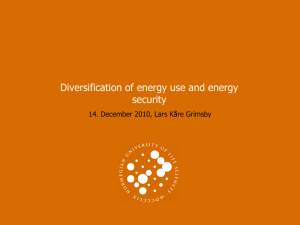Gender diversity: Why?
advertisement

GENDER DIVERSITY: Looking for differences on corporate boards Gro Ladegård 1. 2. Associate professor UMB School of Economics and Business 3. Oslo University College www.groladegard.no UNIVERSITETET FOR MILJØ- OG BIOVITENSKAP Gender diversity: Why? 1. 2. 3. 4. 5. Democratic argument: women are half of the population and should not be systematically excluded from board positions Legitimacy argument: women on the board advance the firms’ reputation Pool of resources argument: the larger the pool of candidates, the easier to find suitable candidates Competence argument: Women have different backgrounds than men and contribute with different types of competences Social role argument: Women have different social roles and thus different attitudes and values than men. They will contribute to a shift of focus in board tasks 3 and 4 requires that there are detectable differences between men and women on the board that are manifested in behaviour. www.umb.no www.groladegard.no UNIVERSITETET FOR MILJØ- OG BIOVITENSKAP Research on WOCB Human capital differences: – Personal attributes (age, education) – Professional experience (business, ownership and management experience – External linkages (networks and interlocking directorates) Findings: – Women directors are younger – Less CEO experience – Sometimes more non-business backgrounds, sometimes external, sometimes internal www.umb.no www.groladegard.no UNIVERSITETET FOR MILJØ- OG BIOVITENSKAP Human capital: Evidence from Canada and USA Number Percent Business Managers Generalists Specialists Comm. Influentials Insiders 63 45 37 32 16 32.6 23.3 19.2 16.6 8.3 Total 193 100.0 Business Managers Specialists Comm. Influentials Dunn 2010: Female directors in Canada Number Percent Men Women Men 88 6 5 31 9 49 88.9 6.1 5 34.8 10.1 55.1 99 89 100 100 www.umb.no Women Hillman & Cannella 2002: Fortune 1000 firms USA www.groladegard.no UNIVERSITETET FOR MILJØ- OG BIOVITENSKAP Evidence from Norway Business Managers Insiders (ownership) Number Percent Men Women Men Women 204 85 43 56 55 23 217 177 Heidenreich & Storvik 2010: Women on ASA boards USA: Women, more than men, are community influentials (non-business background). Men are typically business managers Norway: Women more often business managers. Men are more often insiders: They are owners or represent owners. Other relevant categories? www.umb.no www.groladegard.no UNIVERSITETET FOR MILJØ- OG BIOVITENSKAP Attitudes and behaviour: Difference in leadership styles Assumptions that women more communal in their behaviour: – Philantropy – Corporate social responsibility – Strategic, qualitative tasks – Contribute to open debate, less conflict Findings: – Ratio of women on boards related to behavioural control, less conflict – Men more autocratic and laissez-faire leadership, women more democratic www.umb.no www.groladegard.no UNIVERSITETET FOR MILJØ- OG BIOVITENSKAP Exploring differences in “quota boards”: Interviews 11 companies that – Existed and were ASAs in 2004 and 2010 – Had one or no women on the board in 2004 and 40% in 2010 – The board had 7 directors or more (40% is beyond the critical mass of 3) 14 persons were interviewed, 8 men and 6 women – Questions of tasks and human capital – Comparing 2004-2010, and men-women www.umb.no www.groladegard.no UNIVERSITETET FOR MILJØ- OG BIOVITENSKAP Sample characteristics Table 1 Sample characteristics: company, board and respondents COMPANY A COMPANY B C OMPANY C COMPANY D Industry Food/grocery Electronic medical records Marine food products IT No. of employees 20 000 (2007) 150 585 6000 2004 2010 2004 2010 2004 2010 2004 2010 Board size 8 8 5 7 6 7 8 9 Number of women 1 3 0 3 0 3 0 4 Male respondents Female respondents 1* (10) 4 (3,3,13,7*) 2 (4,3*) 1 (5) 1 (4) 2 (3,1) 2 (8,3) 1(8*) www.umb.no www.groladegard.no UNIVERSITETET FOR MILJØ- OG BIOVITENSKAP Human capital Table 2: Education and industry experience Women directors (6) Men directors (8) Formal education Master in business administration (2) Law and business economics (1) Master in agricultural science (2)( 1 also have MBA) Master in economics (1) Master in business administration (2) Master in engineering (1) Business administration (2) (1 also with additional IT education) Master in political science and public law (1) Physician (1) Bio engineer (1) Industry/ occupation Politics (executive on environmental issues) Computer industry (executive on innovation) Transport (CEO) Food/nutrition, R&D (CEO) Technology (consultant) Energy sector (CEO) Food/grocery (CEO, chair on board) International healthcare (Senior Vice President) Healthcare technology (CEO) Investment (executive) Telecom (senior vice president) IT industry (product manager) Government (assistant administrative officer to mayor Fish exports (CEO) www.umb.no www.groladegard.no UNIVERSITETET FOR MILJØ- OG BIOVITENSKAP Gender differences in human capital Level of education: all women had postgraduate, while 5 of the 8 men had. 2 women had additional education. Field of expertise/education: Men more different types of education (e.g. medical doctor, political science, bio-engineer). More men are specialists? Women more narrow experiences, and more women were CEOs. Director experience: Women 3,33 years, men 6,8 years. www.umb.no www.groladegard.no UNIVERSITETET FOR MILJØ- OG BIOVITENSKAP Perceived differences Changes from 2004 to 2010: – In 2004 women did not have sufficient human capital, today they have – The women on their board have sufficent competence, but competent women are hard to find – Men and women differ in their opinions: the women say that men and women have similar qualifications, while the men thinks there are few women with sufficient qualifications. (what are the sufficient qualifications?) – Professional experience should count before gender, but men mainly recruit men. www.umb.no www.groladegard.no UNIVERSITETET FOR MILJØ- OG BIOVITENSKAP Perceived differences in board roles and tasks Strategic tasks: More strategic now, mostly because of the NUES guidelines. The work is more rule-oriented – External directors are more strategic, and women are more often external directors. Monitoring tasks: Board members differ regarding their emphasis on these tasks, and this is related to their background and daily work. – Monitoring role is conceptualised differently: Women say ”follow rules”, men say ” control is important”. – Two kinds of people: rule followers vs. value creators. Dependent on the industry specific background Service tasks: The chairperson are the one giving advice to the CEO, and only on request. www.umb.no www.groladegard.no UNIVERSITETET FOR MILJØ- OG BIOVITENSKAP Board culture and decision making culture Discussions: open discussions, all participate. More women and more diverse boards make the discussions better. Men: women have other perspectives. Women: we contribute to good discussions, not necessarily because we have different perspectives. More pleasant atmosphere in discussions. www.umb.no www.groladegard.no UNIVERSITETET FOR MILJØ- OG BIOVITENSKAP Board development tasks and structure All prepare themselves better in 2010, but that is because of the NUES guidelines. (some assert that women are more diciplined than men, and that newcomers prepare themselves better) No ”alliances” or hidden decisions between the meetings Structuring of tasks: Board work is more formalised now. 3 out of 4 boards have a selection/recruitment committee. www.umb.no www.groladegard.no UNIVERSITETET FOR MILJØ- OG BIOVITENSKAP General perceptions One man: – Women are more considerate than men – Men are more risk-taking Listening skills: men feel women are better listeners, women do not. Overall a better working atmosphere. www.umb.no www.groladegard.no UNIVERSITETET FOR MILJØ- OG BIOVITENSKAP Summary Women are more narrower recuited Have more education and are more often managers Men are more often owners – Recruiters are risk averse, or stereotype – The ideal type of a director has board experience and management experience. Women do not have board experience: status balance requires management role and higher education for women. Social roles, topics of interest, behaviours, appear to be similar between men and women – Board directors have well-defined roles, and the pre-selection is extensive. – Stereotypical roles (women being more communal in their behavior) is not supported www.umb.no www.groladegard.no UNIVERSITETET FOR MILJØ- OG BIOVITENSKAP Quota law The most important attribute for diversity is background and experience Diversity on corporate boards has not increased, as women are more narrowly recruited The total competence of each board may have increased, if women replace less competent men (we do not know) Stereotyping is obviously common, as men and women often have different opinions about gender differences The ideal type of a board director may be subject to change in the future Recruitment processes could be investigated further www.umb.no







